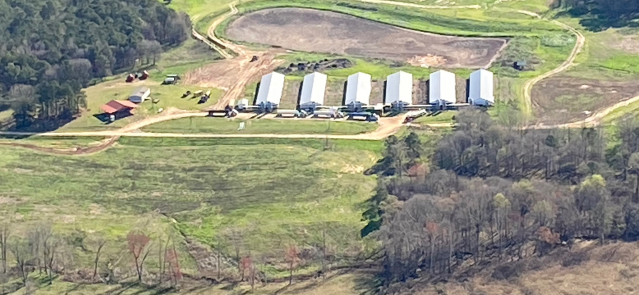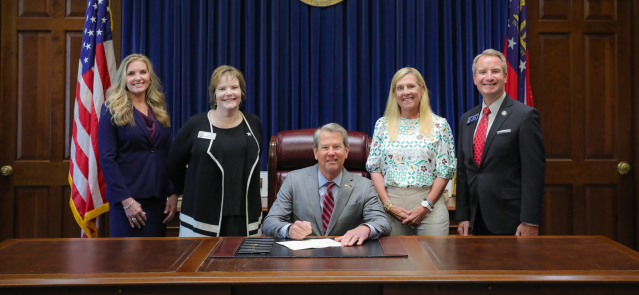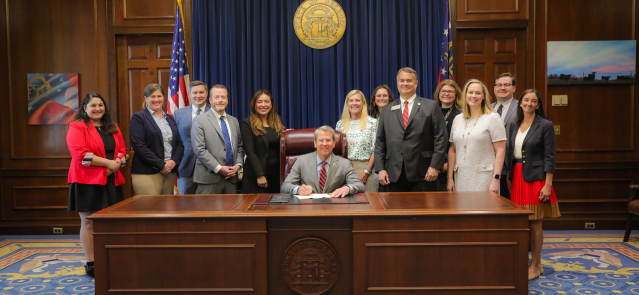Stay ahead of the curve as a political insider with deep policy analysis, daily briefings and policy-shaping tools.
Request a DemoHow Georgia’s 8-year-old infrastructure initiative is paying off
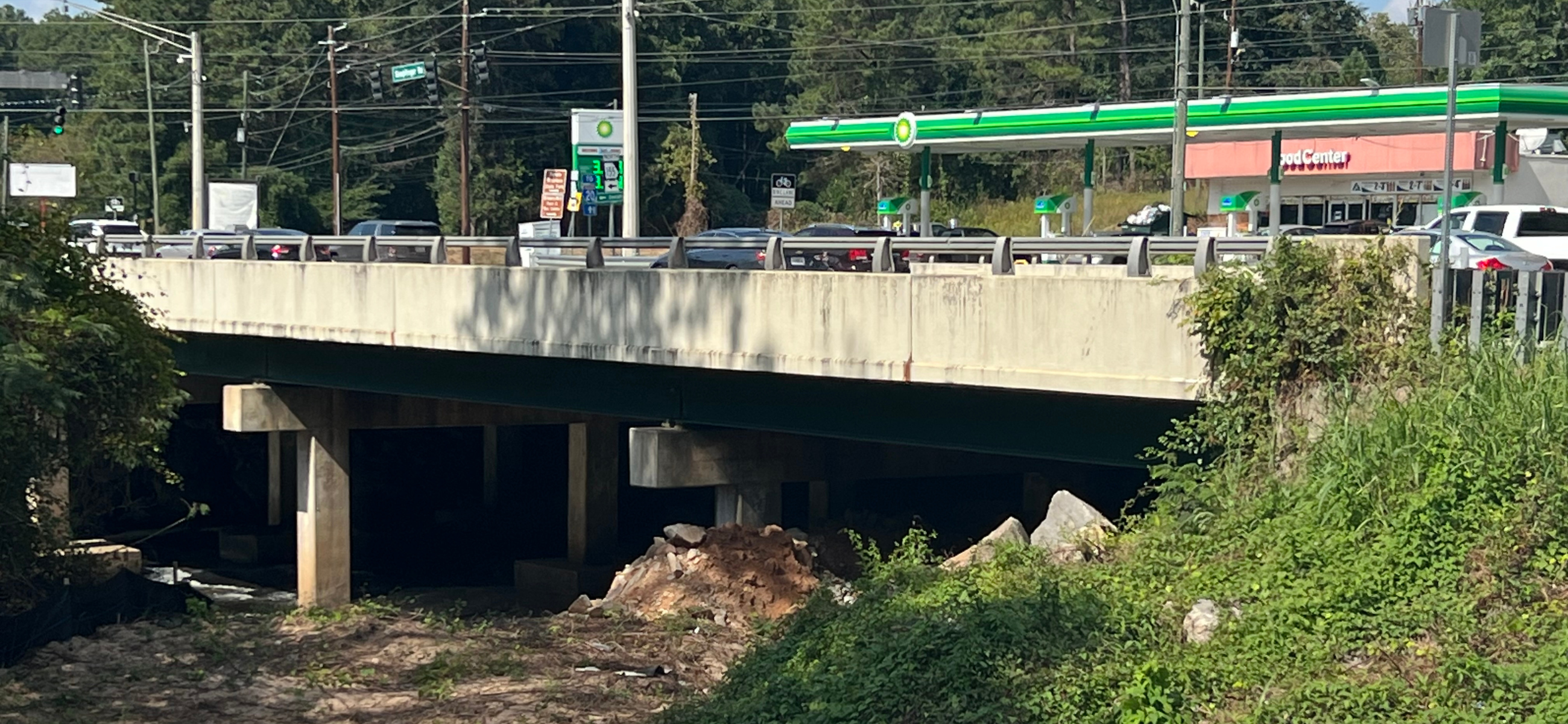
The bridge on Snapfinger Road in DeKalb county crosses over Snapfinger Creek. A national report said it is one of Georgia’s most traveled bridges, and one of its most structurally deficient bridges. It was built in 1954. (Credit: Tammy Joyner)
The Gist
Six years ago, Georgia had more than 700 bridges in poor condition. Today, the state’s list of structurally deficient bridges has fallen to 239.
In fact, fewer than 2% of Georgia’s 15,022 bridges are classified as structurally deficient now — a feat that hasn’t gone unnoticed by those who track the condition of the nation’s 617,000 bridges. The number of bridges in poor condition dropped nearly 66% in just the last four years.
“That is very impressive to go from 441 [structurally deficient bridges] down to 239,” Alison Black, chief economist of the American Road & Transportation Builders Association, told State Affairs. Black has tracked and written reports about U.S. bridges for a decade.
What’s Happening
Georgia ranked 48th nationally in percent of structurally bad bridges and last among states where the percentage of the deck area — the surface on which vehicles drive — is structurally deficient, according to the association’s report released in August.
“This is a list [where] you want to be on the bottom,” Black said. “So that really indicates just looking at the data, that this has been ... maybe a priority might not be the right word. Again, I don't want to speak for the [Georgia] DOT [Department of Transportation] but they have definitely put resources towards addressing this issue in the state.”
So what’s behind Georgia’s performance?
In July 2015, state lawmakers launched an innovative transportation funding initiative. Then-Gov. Nathan Deal signed into law the Transportation Funding Act to provide money to repair, improve and expand Georgia’s infrastructure, including bridges. The state has allocated “another $1 billion a year” for the nation’s 10th largest infrastructure network through proceeds raised from state gas taxes.
“Gov. Deal, and our current administration as well, was firm that bridges are important, whether they're local or state-owned, and we are going to invest in bridges,” Meg Pirkle, chief engineer at the Georgia Department of Transportation, told State Affairs. “So starting in 2016, we increased our spend on bridges, I would say times three or four every year and we are maintaining that.”
While the 239 bridges are in poor condition, most are still in use. For instance, nearly 28,000 motorists cross DeKalb County’s Snapfinger Road bridge on any given day.

Lorenzo Parks uses the bridge that crosses Snapfinger Creek about twice a month, yet he had no idea that it’s among the top 10 most traveled and structurally deficient bridges in Georgia.
“People need to be better informed about the situation, maybe that way we can share our concerns,” the 70-year-old Decatur resident said recently while gassing up his black Silverado Chevy pickup at a gas station across from the bridge.
“Poor condition doesn't mean they [the bridges] are dangerous. It just means that there's things that need to be fixed,”Pirkle said.
Why It Matters
All bridges — state and local — are inspected every other year, she said.
“If they need attention, we provide the correct attention. We’re going to close the bridge if it needs to be closed. If it needs maintenance, we're going to do the maintenance and if it needs to be replaced, we put it on the list for replacement,” Pirkle said. “So it's not like I worry at night that people are driving over a bridge that has a poor rating because I know that it's safe.”
Currently, there are 49 bridges in Georgia that are closed, only one is owned by the state.The rest are owned by local governments.
“For the most part, a lot of our bridges are in the good and fair state,” State Bridge Engineer Donn Digamon told State Affairs.
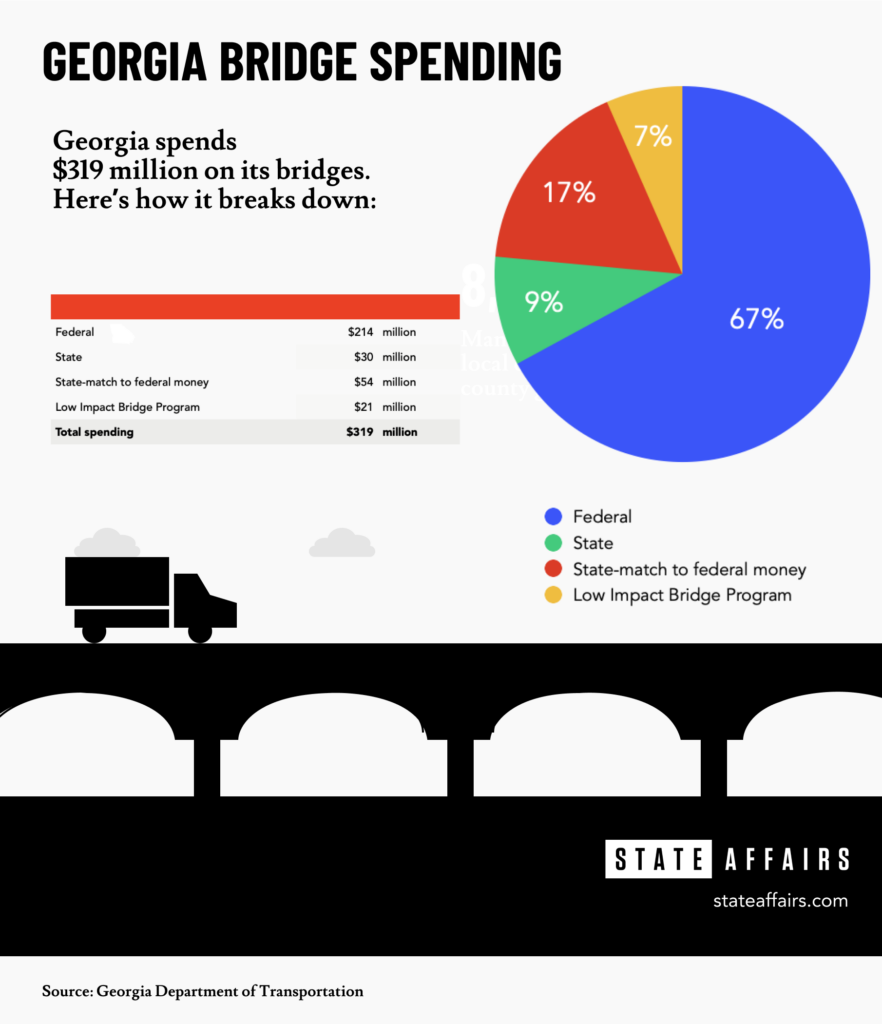
In addition to state money, Georgia gets a total of $225 million in federal bridge formula money through 2025. The money comes from the $1 trillion Infrastructure Investment and Jobs Act Pres. Biden signed into law in 2021 to invest in roads, bridges, railroads and broadband internet.
While states have access to $10.6 billion in federal infrastructure money, only 30% of that money has been committed to 2,060 bridge projects nationwide as of June. Georgia, however, already has committed all of its available $90 million federal infrastructure money to 54 projects.
The Georgia Department of Transportation still has work — and challenges — ahead.
Georgia has 13,740 bridges in need of some sort of repair, up slightly from the 13,676 bridges that needed work in 2019, according to the American Road & Transportation Builders Association’s report which is based on findings from the Federal Highway Administration’s National Bridge Inventory.
Complicating matters: Bridges in some parts of the state are now handling trucks carrying heavier loads.
State lawmakers passed a bill in March allowing trucks in the agriculture and forestry industries to carry heavier loads. Gov. Kemp signed HB 189 on May 5. The new law allows trucks in those industries to haul up to 88,000 pounds, up from 84,000 pounds. The trucks can travel up to 150 miles from the farm or processing plant where the load originated. The law is good through June 2025, giving lawmakers time to reach a permanent compromise.
State officials told lawmakers earlier this year that more than 700 bridges in Georgia can’t handle the increased weight limits. Those bridges include 306 state-owned bridges and 427 local bridges. The state has since posted weight limits on 733 bridges, Digamon said.
“We do know that these heavier weights, or what we call axle weights, the individual axles just over time — when you give anything time — will accelerate the pace of deterioration,” he added.
The heavier weight is most likely to be a problem in rural areas. More than half of all truck trips in Georgia pass through rural areas at some point during their journey, according to the Georgia Chamber of Commerce Third Quarter report released earlier this month.
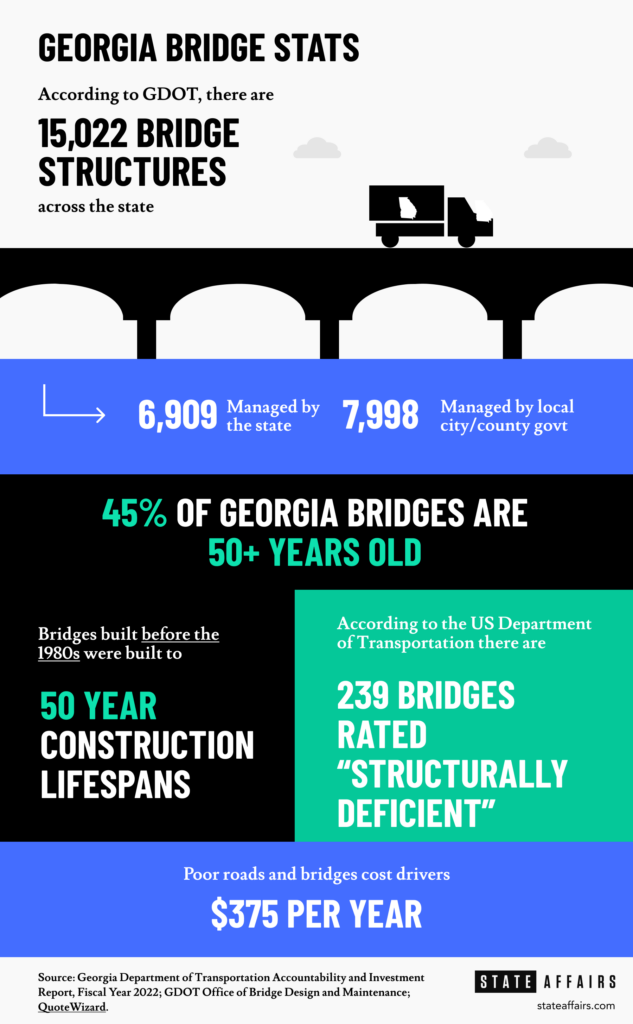
Weight-posted bridges require detours that are nearly 35% longer, on average, in rural areas than posted bridges in metro Atlanta, the report noted. Declining bridge conditions pose a serious mobility issue for motorists and railways. Some 13% of bridges in rural areas are posted with weight restrictions compared to 7% in metro atlanta
“This is causing connectivity issues in rural Georgia,” the report said.
Nationally, 1 in 3 bridges need to be replaced or repaired, even as the country’s share of bridges in poor condition continues to slowly improve, the report said. At that current rate, it would take 75 years to fix all of the bridges that need work, the report noted.
“We really increased our spending on bridges because Georgia is a growing state and keeping our bridges in good health is so important for not just the interstates but for agriculture and growth in and around the ports and everything,” Pirkle said. “I mean, it can really restrict travel if you have restrictions on bridges.”
What’s Next?
Earlier this year, national auto insurance comparison company QuoteWizard ranked Georgia as having the best infrastructure in the nation. As a result, Georgians have the fifth-cheapest driving costs in the country, paying about $375 a year.
“The goal is always to be providing the biggest bang for the buck for the taxpayer because this is all taxpayer money.” Digamon said. “So, I think we're doing a fairly good job at this point for the taxpayer of Georgia.”
GEORGIA BRIDGES: BY THE NUMBERS
State and local bridges inspected annually: 8,824
State-owned bridges repaired annually: 46
Average age of a bridge in Georgia: 46.3
State-owned bridges repaired so far this year: 142
Bridges in good condition: 77.7%
Bridges in fair condition: 21.3%
Bridges in poor condition: 239 or 1%
Bridges currently closed: 49 – 1 state-owned; the rest are local government-owned
Bridge replacement and construction projects: 154
Total cost of those projects: $821 million
Source: Georgia Department of Transportation Accountability and Investment Report, Fiscal Year 2022 and National Bridge Inventory, Georgia data, 2023.
Have questions, comments or tips? Contact Tammy Joyner on X @lvjoyner or at [email protected].
X @StateAffairsGA
Instagram@StateAffairsGA
Facebook @StateAffairsGA
LinkedIn @StateAffairs
Read this story for free.
Create AccountRead this story for free
By submitting your information, you agree to the Terms of Service and acknowledge our Privacy Policy.
Rural communities hopeful Kemp change to state soil amendment law will curb stink
After seven years and millions of dollars in restoration, Heritage GA opened its door last month to those seeking solitude and a chance to commune with nature. But the constant presence of trucks hauling a noxious concoction of waste byproducts from poultry processing plants threatens to ruin those plans.
The historic Catholic retreat sitting on 200 acres near Sharon is meant to be an economic boon and tourist attraction for Taliaferro (pronounced “Tolliver”) County, a poor, mostly Black county of 1,600, situated 90 miles east of Atlanta.
“It’s a very historic, sacred site. Our business is being threatened by this soil amendment. It’s [the retreat] been a major financial investment in the county and in the state and it’s really helping,” Betsy Orr, chief executive officer of Purification Properties LLC, which restored the retreat — a tribute to the first Catholic settlers who arrived in Georgia in 1790.
The sludge, known as soil amendment, is being transported to a hog farm about 1.5 miles from Heritage. The former hog farm was cited by the state Environmental Protection Division after residents complained that the waste being spread on the farm had polluted a nearby creek. The property owner resolved the consent order requiring him to pay $5,000, mark the buffer area on the farm and ensure no soil amendment is applied to that area, according to EPD spokesperson Sara Lips.
The Heritage property includes a commercial building, barn, cottages, prayer spaces, walking trails and the oldest Catholic Cemetery in Georgia. Orr predicts that if the smell from the former hog farm reaches Heritage, “it’s going to wreck our business.”
On Monday, Orr breathed an inward sigh of relief when she learned that Gov. Brian Kemp signed a bill into law that could prove fortuitous for landowners and other businesses battling problems created by soil amendment.
The new law adds a provision to the state Soil Amendment Act of 1976 that stops companies from hauling or receiving soil amendment if they’ve been notified by EPD to resolve an outstanding dispute or complaint. The notification is known as a consent order. The new law is effective July 1.
“It’s good because the state and the Agriculture Department have really prevented that kind of bill from being enacted because they say that it’s to the farmer’s benefit to be able to use the soil amendments,” Orr said.
Orr’s comments are a common refrain from business owners and families with properties in rural Georgia who sit near soil amendment sites and who complain of vultures, hordes of flies and unbearable smells floating across their properties.
“The problem is a lot of the soil amendments are causing pollution. They are stinky, nasty wastewater and other products,” Orr said. “Sometimes it is not even what they are allowed to dump. Finally, they have passed this amendment, and I hope they enforce it. Some of the things that these people are dumping are … ruining the landowners around them and the state has got to start caring about that.”
Doug Abramson, a retired corporate lawyer who lives in Wilkes County where a soil amendment runoff killed 1,700 fish in the Little River July 2022, called the new law “a step in the right direction.”
“Many counties throughout the state are encountering problems with sludge, improper dumping, and [other] soil amendment issues,” said Abramson, who along with his wife Susan have been working to address the problem for about a decade. “This [new law] is at least a recognition that there are problems out there. I do think the state could do better. The Department of Agriculture could do better but it is a step in the right direction.”
Have questions? Contact Tammy Joyner on X @lvjoyner or at [email protected].
Watch live: Kemp signs $36.1B budget bill
Today is the deadline for Gov. Brian Kemp to either sign or reject bills passed by the Georgia General Assembly during this past legislative session. Arguably, the biggest of those bills is the annual budget. Kemp and first lady Marty Kemp will be joined by Lt. Gov. Burt Jones, House Speaker Jon Burns, and members …
Bill adds violation to Soil Amendment Act, but will it stop the stench?
After years of enduring intrusive, foul-smelling waste spread on untold tracts of rural land, Georgians living near such sites are finally getting some relief.
On Monday, Gov. Brian Kemp signed into law a bill that adds a new violation to the state’s 48-year-old Soil Amendment Act. Soil amendment is meant to help farmers create healthier soil.
The law’s new provision is being hailed as a small but significant breakthrough in a 15-year battle to rein in abuses and mismanagement and create more safeguards and oversight in the disbursement of soil amendment. Many rural communities have long complained that the state-approved, sludge-like substance smells like “rotting corpses,” draws flies and vultures, and has led to other environmental problems.
Soil amendment is a state-approved additive derived from waste created mostly at chicken-processing and pet food-processing plants. It’s intended to be used as fertilizer on farmland where crops are grown. It’s supposed to help reduce erosion, improve water retention, change soil pH, pump up nutrients and provide other soil-boosting enhancements. Georgia law allows chicken processing waste to be applied to land as a soil amendment. Some farmers use it as a cheap alternative due to the rising cost of fertilizer.
The new provision, which goes into effect July 1, makes it illegal for a company to continue spreading soil amendment if the company or the site in which the waste is being distributed is under some kind of enforcement action from the state Environmental Protection Division or the state Department of Agriculture, the bill’s sponsor Rep. Rob Leverett, R-Elberton, told State Affairs Monday. Violators must be notified by the agriculture department and must resolve the prior problem before they can resume dispersing more soil amendment, he added.
“I’m very excited. I appreciate the governor signing the bill,” said Leverett who lives in Elbert County where some residents have had problems with soil amendment. “The passage of the bill indicates there’s some recognition by the Legislature that we do need to take a look at this. What I’m trying to do is address what I believe to be legitimate complaints. Hopefully, we started to do that this year and we’ll take other incremental steps as needed. I look forward to the Ag department enforcing this new violation once it’s gone through their regulatory process.”


David vs Goliath
In a state where agriculture wields tremendous power — it provides paychecks for 1 in 7 Georgians and contributes about $75 billion a year to the state’s economy, most of it from poultry processors — the new legislation is a milestone, local government officials and activists say.
“It is a very big step,” Tonya Bonitatibus, executive director and riverkeeper at the environmental nonprofit Savannah Riverkeeper, told State Affairs. “This bill made it through the Senate and the House Ag committees, which are traditionally definitely not in the business of overregulating Ag, and it passed almost unanimously [in the Legislature] and that speaks volumes.” Bonitatibus has been tracking the issue for 13 years.
While state lawmakers are recognizing the harsh impact the state’s poultry industry waste is having on some rural communities, leaders in those communities are waiting to see what the Georgia Department of Agriculture does. The department has sole power to regulate soil amendment.
“I hope the new [agriculture] commissioner Tyler Harper brings us more positive results,” said Oglethorpe County Commission Chair Jay Paul, a former state Environmental Protection Division specialist who dealt with soil amendment most of his 17 years with the agency. “I’m trying to give him the benefit of the doubt.”
Shortly after taking office in January 2023, Harper vowed to review the department’s Soil Amendment Program. Since then, he has issued recommendations and is beefing up the program, which when he arrived had only two people, one of whom was the inspector for the entire state. With $550,000 in funding from the state, Harper has added two more inspectors, a program manager and an attorney.
The department is updating its software so inspection reports can be completed digitally and tracked online rather than hand-written. It’s also updating its licensing and registration software to help registrants more easily comply with soil amendment program rules.
“Our team has done a really good job,” Harper told State Affairs. “We’ve really been working to get our arms around it since I walked in the door last year, and we’ve been committed to addressing the issue and ensuring that the agricultural industry can be successful and that we’re protecting our state, our resources and the public all at the same time.”
Rep. Robert Dickey, chairman of the House Agriculture Committee said Leverett’s bill is “about the [state agriculture] department having some teeth in the rules and law to really shut down” companies with abusive soil amendment practices.
The Ag department’s recent efforts are more than what’s been done in the past, critics say, but more needs to be done.
“I really haven’t seen a whole lot of difference. I mean, we’ve heard some good rhetoric,” Wilkes County Commission Chairman Sam Moore told State Affairs.
“Unfortunately, it’s the little bitty counties against the Department of Ag. And we lose every time,” Elbert County Commission Chairman Lee Vaughn said. “The Department of Ag has 100% control over what soil amendments are and what they allow and how they allow them to be applied.”
Local leaders in counties affected by the sludge onslaught say they’ve been kept in the dark for years about soil amendment. To make matters worse, they say they have no regulatory authority to resolve the problem because that’s left up to the state agriculture department.
“We want to know where it’s going. We want to know what it is,” Moore said. “I mean, we don’t even know if they [sludge-hauling companies] have a permit or not. You call the Department of Ag and they act like they don’t know. It’s just the same old thing that’s been going on for years.”
In the last year, some counties have started fighting back, creating local ordinances that discourage the sludge haulers from coming into their communities. At the same time, the problem has sparked activism among local residents in several counties where the problem prevails.
‘Death and Diarrhea’
State Affairs spoke to local government officials, activists, environmentalists, farmers and residents in a half dozen counties where soil amendment has been applied for years. Their stories all seem to align.
They talked about how their communities have been overrun with tractor-trailers hauling millions of gallons of sludge — or as locals call it “chicken blood and guts” — presumably from chicken and dog-food processing plants. The additive is being spread on open land in rural communities — usually small, sparsely-populated counties — across Georgia, with little state regulation, scrutiny or intervention.
The companies bringing in the waste have contracted with or paid farmers or landowners to apply it on their property. Some locals report seeing dozens of tanker-trucks a day hauling the waste into their communities. It’s an endless procession where the sludge is applied throughout the day, all hours of the night and even in the rain.

The usual hoot owls and honey bees have been replaced by vultures and flies, community members say. Millions of flies land on farm animals and get entangled in children’s hair when they play outdoors. In Hancock County, locals have resorted to firing shotguns in the air to scare away the vultures perched atop churches and other buildings. The vultures feast on the land where the soil amendment has been deposited.
“Buzzards or vultures, whatever you want to refer to them as, eat dead rotting flesh,” said Angela Walden who lives in Jefferson County, 45 minutes south of Augusta.
Dirt roads have become muddy, well-worn crevices as dozens of tanker trucks haul tons and of the liquid ooze into communities nonstop.
In most instances, the sludge is spread on top of the soil, locals and officials say, instead of injected into the ground, as the state requires, creating a horrific stench that stretches for miles.
“It smells like death and diarrhea,” said Patrick Dragos, a former Seattle ironworker who moved his wife and daughter to Jewell in August 2022. The family owns an historic wedding venue on a 42-acre estate with an 1895 Victorian home and barn near the Ogeechee River.


Dragos was so incensed after getting nowhere with state and local officials and the sludge-hauling companies that he is now running for chairman of Hancock County Board of Commissioners. The 34-year-old Republican is running against three Democrats, including the incumbent Helen “Sistie” Hudson who has held the seat since 2016.
“If they’re not going to handle our issues and take this seriously, I guess I’m going to have to do it myself,”Dragos said.
Problems began near the Dragos family’s Hancock County property in March 2023 when soil amendment was applied to a farm about a mile away. The smell and flies continued through October, leading Dragos to believe the problem was over. Then, the sludge-filled trucks returned in March of this year and have shown up frequently since then.

The family’s heading into a busy season of weddings, graduations and baby showers and never know when the trucks and smell will show up.
“The threat of the smell and flies is constant. So that stress is always there,” Dragos told State Affairs.
Dragos worries that nonstop application of the soil amendment may eventually seep into the water tables and eventually his well water.
It’s already created one environmental mishap.
In July 2022, some 1,700 fish died in the Little River in Wilkes County after soil amendment runoff from Mar-Leta Farms leached into the river, a Georgia Environmental Protection Division report found. The waste came from washdown water at a Hartwell County Nestle Purina facility provided by a company called Proponic Solutions, according to the EPD report. The report described the waste as “grey, turpid wastewater.” Mar-Leta, also known as McAvoy Farms, was later fined $85,000.
“It’s a major environmental concern,” said Paul, the Oglethorpe County Commission chairman. “And I’m not convinced that the fish kill in Wilkes County will be the last one because nobody really knows what’s in it. It’s just that simple. It comes as wastewater and suddenly goes on a truck and it becomes soil amendment.”
Fighting Back
Unable to get much help from the state agriculture department for years, some counties have taken steps to deal with the problem themselves:
In Warren County, companies wanting to apply soil amendment have to notify the county and get a permit to do so, Commission Chairman John Graham said. The companies also are limited to storing the sludge in certain industrial areas of the county and onsite for no more than 12 hours.
The ordinance was put in place about a year ago so that county officials “ would have more knowledge of what’s going on,” Graham said. “We’re going to stand on our ordinance. Our attorney put it together and he said he followed everything [based on the law]. He feels like we did the right thing.”
The issue had become such a problem that the county was forced to close one dirt road because “they had brought so many tanker-trucks of that stuff in, it messed up the dirt road. With all the rain we’ve had and them bringing in 20 trucks a day and that weight on a muddy dirt road just ruined it,” Graham said, adding that activity has “slowed down in the last little while,” Graham added.
Oglethorpe County created an ordinance last June that requires companies applying soil amendment on a tract of land to be at least 100 feet away from the property line of the nearest private property. During the 2021-22 legislative session, Senate Bill 260, sponsored by then-Sen. Tyler Harper, limited local buffers and setbacks to 100 feet.
“If we get a complaint, we will at least go out there and walk the perimeter of a property and make sure they’re not within 100 feet,” Paul said. “If we see something more egregious, like septage [human waste] for example, we can turn it over to the George Environmental Protection Division. It [Oglethorpe’s ordinance] does give us something new but that’s about it.”
Probably the strongest local government push back comes from Wilkes County. Two months ago, county leaders adopted an ordinance that requires landowners to prove they’re using the land where soil amendment is being applied to grow products, not just as a dumping ground. One soil amendment-application company sued the county two weeks ago saying the ordinance is illegal.
“Who knows what’s going to happen,” Moore, the Wilkes County Commission chairman, said when asked about the county’s chances of winning. “You would think we’d have a good chance. [But] We’ve been dealing with the state for so long, our expectations are not real high.”
Accidental Activists
The ongoing sludge fight has also created a motley mix of NIMBY activists.
Angela Walden and her husband had plans to build their dream home on their family’s nearly 200-year-old farm in Jefferson County. Those plans died on July 13, 2022 when they got the first whiff of a mysterious sludge that had been spread on her cousin’s farm across the two-lane highway dividing their properties.
A month later, Walden’s husband, who often tended the family farm after working his day job, got sick. He was vomiting. He had a sore throat, watery eyes and headaches. He was ultimately diagnosed with thyroiditis, a condition that occurs after coming in contact with hazardous toxins. That was the beginning of the Summer of Hell — 69 days of stomach-churning stench and flies — for Walden and her family.
It was also Walden’s swift induction into activism that would take her to the state Capitol to fight against the substance that ultimately caused a family rift that continues to this day.
“It’s small town, rural Georgians up against big industry,” said Walden, who has appeared in a Rural Georgia Protection Alliance documentary about soil amendment. “The chicken industry is big in our state. You’re going up against them, these lobbyists who have millions of dollars and big time attorneys. And you have the politicians. If I can just inform my county, my residents about what this really is and to try to keep it out of my community … that’s the best way to combat it.”
Walden wants to see regulatory authority over soil amendment removed from the state agriculture department and returned to the state’s Environmental Protection Division.
“That would be a huge win,” she said. “You know, we have to do what we can to try to bring some regulation and some oversight to what they’re doing.”
Have questions? Contact Tammy Joyner on X @lvjoyner or at [email protected].
House speaker Jon Burns hires new communications director
House speaker Jon Burns, R-Newington, announced today that he has hired a new communications director. Kayla Roberson, who has served as press secretary at the Georgia Chamber for the past year or so, will now oversee all external communications, media relations and strategic messaging for Burns.
“I’m excited to welcome Kayla to our team,” Burns said in a statement. “Kayla has an excellent background, deep skill set and strong work ethic, and we’re excited to have her on board to continue getting our message out and sharing the House’s priorities ahead of and into the next session.”
A double major in political science and journalism at the University of Georgia, where she graduated in 2022, Roberson interned for U.S. Rep. Andrew Clyde, a Republican in north Georgia’s 9th Congressional District, and worked as a consultant for GOP political candidates before joining the Georgia Chamber.
“I’m beyond grateful for the opportunity to work under the leadership of speaker Burns,” Roberson told State Affairs. “Whether it’s improving education opportunities, putting money back in the pockets of hardworking Georgians, creating jobs or supporting our rural communities, speaker Burns always prioritizes doing what is best, and what is right, for Georgia.”
Political strategist Stephen Lawson, who has held the top communications role for the speaker since last December, announced he’s joining Dentons, where starting today he’ll lead the global law firm’s public affairs efforts.
Have questions or comments? Contact Jill Jordan Sieder on X @journalistajill or at [email protected].

